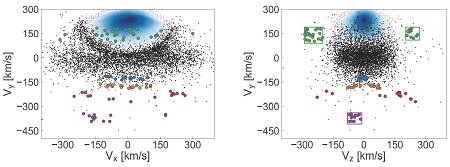New GAIA data reveals mergers in Milky Way
University of Groningen astronomers have discovered relics of merger events in the Milky Way halo. Five small groups of stars appear to represent mergers with smaller galaxies, while a big ‘blob’ comprising hundreds of stars appears to be the remnant of a large merger event. These results were published in The Astrophysical Journal Letters on 12 June.

The study is based on the recent Gaia Data Release 2. This provided the astronomical community with accurate information on the position and movement of millions of stars, mostly in the Milky Way. PhD student Helmer Koppelman is part of the research group of Professor of Dynamics, Structure and Formation of the Milky Way Amina Helmi, who has been involved in the Gaia mission almost from its inception. He started analyzing the data right after the release and published a preprint of the article just eight days later. This has now been officially published.
Halo
‘Our aim is to study how the Milky Way has evolved’, says Koppelman. The idea is that smaller galaxies merge to form larger ones. ‘One of the questions is whether a lot of small galaxies merge or a few large ones.’ As most stars in the Milky Way’s halo – the spherical cloud of stars surrounding the main disk and bulge of our galaxy – are thought to be remnants of merger events, Koppelman and his colleagues focused on halo stars in the Gaia data.
‘We collected information from stars within 3,000 light years of the Sun, as the accuracy of the position and movement is highest for stars that are near us’, Koppelman explains. The first step was to filter out the stars from the Milky Way disk. ‘These stars move around the centre of the disk, so are easily identified.’ What remained were about 6,000 halo stars.

Blob
By calculating their trajectory, Koppelman was able to identify stars with a shared origin. ‘We discovered five small clusters which we believe are remnants of five merger events.’ However, many of the remaining stars also appeared to have a shared history. ‘These stars form a huge “blob” with a retrograde movement compared to the disk. This suggests they are the result of a merger with a large galaxy. In fact, we believe that this merger event must have remodelled the disk in our Milky Way.’ A more detailed study of the nature of this merger is now underway. ‘At this point in time, we can say that our Milky Way was shaped by a massive merger event and some smaller mergers.’
Koppelman also looked for stars belonging to the ‘Helmi stream’, which is named after his PhD supervisor who identified it back in 1999 as the remnant of a merger event. ‘Up to now, fewer than twenty stars belonging to the Helmi stream had been identified. The Gaia data has added over a hundred new stars.’ Further analysis should clarify the nature of the galaxy that produced this stream. ‘We will also be looking at stars beyond 3,000 light years to discover more members of the different streams we identified. Together with simulations of galaxy evolution, this should give us exciting new insights into the evolution of the Milky Way.’
Reference: Helmer H. Koppelman, Amina Helmi, Jovan Veljanoski: One large blob and many streams frosting the nearby stellar halo in Gaia DR2. APJ Letters, 12 June 2018, DOI: 10.3847/2041/aac882
More news
-
15 September 2025
Successful visit to the UG by Rector of Institut Teknologi Bandung

